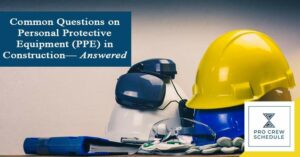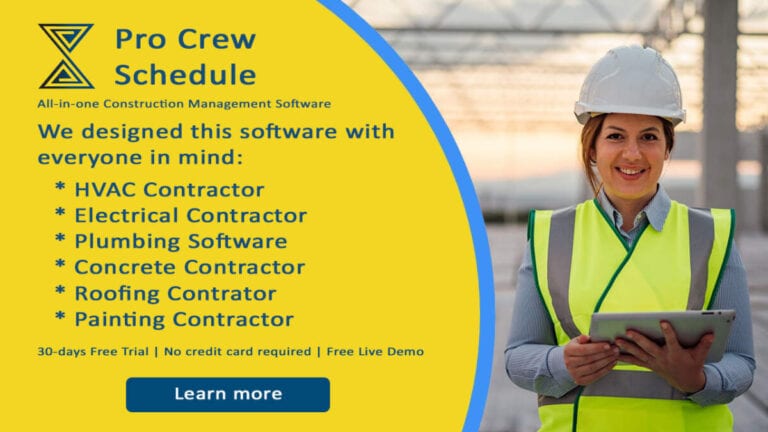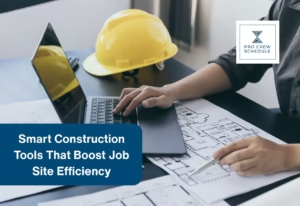Maintaining a safe construction jobsite is critical in today’s construction landscape. While standard methods and processes, ongoing training, and even modern construction technology are all essential first-line defense on a jobsite, workers still need adequate protective equipment as the final layer of safety. That’s the reason why personal protective equipment (PPE) is mandated gear or clothing worn by workers on-site when they’re working on or even near a potential hazard, like dealing with a dangerous chemical or a steep drop-off.
According to the Occupational Safety and Health Act of 1970, employers are required to implement “safe and healthful” workplaces for their employees or workers– which includes a supply of PPE devices where they’re needed.
While gearing with PPE might not be every construction worker’s preference when working, it not only significantly reduces the risk of injuries but it also helps your project bottom line by minimizing workers’ compensation costs. Since maximizing profits and minimizing risks are primary goals for all construction businesses, a solid safety PPE program is vital to any growing building venture.
If you have questions regarding PPE use in construction or need to level up your construction safety program, below, we’ll discuss how to get the right gear to keep your workers safe and productive.
Related: Construction Safety: Being Safe On A Construction Site
What Are the Basics of the PPE Program?
To ensure that PPE is being used appropriately and effectively at your construction site, plant, or warehouse, it’s important to know the following:
- When and where workers need PPE
- Which PPE devices apply to which types of situations
- How to maintain the quality of PPE devices
- How to train construction workers in the proper use of PPE
Once you’ve successfully answered how to execute each of those four items above, you will have mastered the basics of PPE practices.
When Do Construction Workers Need PPE?
PPE doesn’t only protect your workers on-site; it also protects your construction business from legal liability and OSHA sanctions. Moreover, Occupational Safety and Health Administration (OSHA) requires that you provide PPE to your workers free of charge.
However,
just because you equip workers with proper gears and devices, it doesn’t mean they will wear them.
Based on statistics from USML Environmental Health and Safety study:
- Only 16% of workers who experienced severe head injuries wear hard hats,
- Only 40% of workers who experienced serious eye injuries wear eye protective equipment,
- Only 1% of workers who experienced serious face injuries wear face protection, and,
- Only 23% of workers who experienced serious foot injuries wear safety boots or shoes.
Numerous worksite injuries are incited not by the lack of available PPE but by construction workers choosing not to wear it, even when they know they should.
This is why the first decisive factor for figuring out when a construction worker should be wearing a PPE is the worker themselves.
If a person is wondering if they should or shouldn’t wear PPE in a particular situation, always depend on the side of caution and order them to gear up with a protective device. It only takes two seconds to put on a hard hat, even a shorter time to be stuck on the head by falling debris. Training and educating your workers on the potential hazards of not wearing PPE is critical for maintaining a “safety first” culture is a priority.
Secondly, recognize that using PPE is only supposed to be used as a last resort after you’ve eliminated all the potential hazards possible.
Establish a standard worksite safety checklist and reduce the risk of each of those items before enforcing the use of PPE devices. Once you’ve eliminated as many risks as possible, that’s the time to think about finding the right PPE for the remaining worksite risks. Furthermore, make sure your workers have immediate access to all safety documents, including OSHA manuals and handbooks. Having these documents available on your mobile construction software, such as Pro Crew Schedule, can also help avoid potential legal fines during the “surprise” site visits.
Lastly, to officially decide whether or not workers need PPE, ask yourself if the environment your workers are working in could cause injuries to any of these five areas of the body:
- Eyes: From flying particles, dust, or splashes of liquid
- Skin: From exposure to chemicals or touching corrosive equipment or tools
- Body: From extreme (cold or heat) temperatures
- Lungs: From inhaling contaminated air or poisonous chemicals
- Head and Feet: From a falling piece of debris and materials
If your construction worker is working in any area that could cause injury to any of those five areas of the body, they surely need the appropriate PPE devices.
How Do I Know Which Devices I Need?
Using the wrong PPE is as good as not using any protective device at all. For a PPE gear to be effective, it needs to properly ward against the construction site hazards, correctly fit the user, and integrate with other devices.
To determine which PPE are required for a particular situation, consider answering the following questions:
1. Who is being exposed to what?
A specific task requires a particular type of PPE, but in most cases, your entire worksite could need a common type of equipment for everyone to use. For instance, anyone working on a jobsite could be hit by falling pieces of debris and needs to be geared with a hard hat.
Contrarily, some workers on that same jobsite may be working on the ground while others work on the roof. In this case, only those workers stationed above ground need fall arrest system devices.
2. How much hazard are they exposed to?
Construction worksites contain multitudes of potential hazards, but just because a person is working on a site with a particular hazard, that doesn’t mean exposure to it for long enough to necessitate the use of PPE.
After compiled a list of PPE devices your construction crews need, take your worker’s clothing measurements. A poor-fitting hard hat could cause heat exhaustion or headaches if it’s too tight or fall off anytime if it’s too loose.
Personal protective equipment only works when it fits the user correctly. What works for a male worker may not work for a male employee. It’s vital to consider varying body types and frames when choosing the proper protective gear.
Similarly, if a worker is wearing more than one type of PPE, ensure all the individual pieces fit comfortably together. If a worker needs a respirator and safety goggles, a too-large respirator could push up the goggles, hindering a worker’s field of vision. Make sure each piece a worker wears functions in synchronization with all of their equipment.
3. How long will they be exposed to the hazards?
Ensure that the PPE device you’ve provided your worker for a given task will last for the entire duration of that activity. If a worker is doing a welding task that lasts all day, an essential plastic face mask won’t survive 8+ hours of continuous exposure to heat. Instead, that welder needs a leather and metal or glass face mask. Always consider the amount of time a worker will be exposed to a hazard in order to equip them with the adequate possible PPE device.
Do I Need to Train My Team on How to Use PPE?
The short answer is yes.
When a certain PPE is not correctly used, it can’t do its job – as simple as that. For instance, if a worker’s protective eyewear stays on top of their head rather than over their eyes, that protective eyewear has no purpose.
Training and educating your workers on why they should wear a particular type of PPE when the device should be used, the risks associated with not wearing the PPE device, and its limitations should all be provided in a comprehensive safety training program.
Additionally, it’s essential to teach all workers that just because a task “only takes a few minutes,” it doesn’t mean that not wearing PPE is justifiable.
An on-site worker is just as likely to have sand or dirty fly into their eyes whether they’re carrying sacks of stones for five hours or “only” five seconds.
Related: 9 Construction Wearable Technology Redefining Site Safety
What Are The Needed Maintenance of PPE Devices?
It goes without saying that properly cleaning and storing PPE devices in well-kept, dry storage spaces are important for device maintenance, but that is not the end of your maintenance process.
Thorough maintenance entails regular device inspections twice a day: before workers put the PPE device on and when they take it off.
A construction job is physically exhausting not just to workers’ bodies but also to their equipment. A cord could rip, or a screw could come loose at any given. Taking five seconds to look over PPE devices for potential damage could be the difference between a safe day of work or a severe injury on site.
It’s also critical to keep replacement parts on the construction inventory at all times in case something gets broken.
Key Takeaways
Construction job sites are full of risks and hazards. Reducing dangers with the right equipment and gears will ensure that your workers can keep working healthily and happily. The right PPE is essential for keeping them productive and safe on projects. By adopting the PPE practices above, you increase your chances of getting the job done right with less risk and costs.







